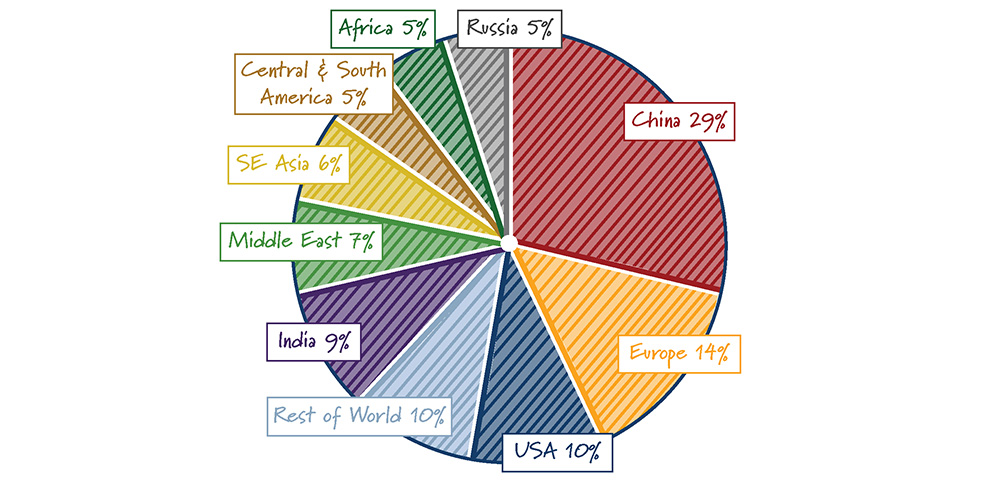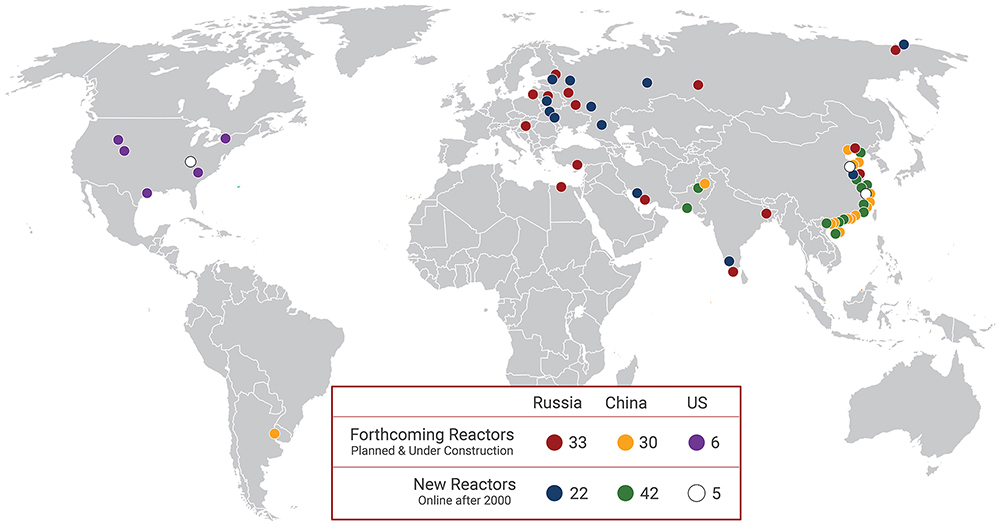As the world’s energy needs grow, America’s leadership and innovative solutions are a beacon to solving diverse and ever-changing challenges. Alongside allies and partner nations, the United States will ensure that energy and environmental priorities are addressed in a clean, affordable and reliable manner.
The U.S. has made historic investments in the demonstration, deployment and expansion of innovative, clean energy technologies. As a result, America represents an increasingly smaller portion of global energy emissions. Looking ahead, America needs to lead the way in ensuring these technologies find pathways to the rest of the world, benefiting economic, national security and environmental goals.

Source: International Energy Agency, World Energy Outlook 2023
Total emissions estimates are based on a notional extrapolation based on current trends
Accelerating the export of next-generation energy technologies can drive the large-scale deployment needed to meet climate goals. Expanding into global markets also positions the U.S. as a key partner in the future of clean energy while seizing a valuable trade opportunity. Some estimates suggest that U.S. exports of clean energy technologies could generate approximately $330 billion annually by 2050. Moreover, the adoption of these technologies could lead to a global reduction of 20 gigatons of emissions per year by 2050, which is equivalent to the carbon dioxide emissions from over 8.6 million cars.
Trade and Investment Policy – America’s network of trade agreements is a powerful dimension of global leadership and should be continually expanded and improved to secure overseas markets for U.S. clean energy exports. However, China is the top trading partner to more than 120 countries. For the U.S. to maintain leadership in brokering fair, transparent trade deals with high standards, it must have a strategic, pro-market trade policy – with Congressional engagement – to permanently eliminate trade barriers to clean energy products and services across international markets. Collaboration with partners and allies through trade and investment can advance the next generation of energy technologies while offering an essential alternative to nations that threaten international energy security and climate goals.
Development Finance – As global energy consumption increases, over 760 million people are still left without access to electricity. Developing populations need access to financing in order to build necessary energy infrastructure in a clean, reliable and affordable manner. However, the current development finance landscape is dominated by lending from our competitors and adversaries for substandard projects. From 2016-2021, China provided more energy project financing around the world than the World Bank and all major Multilateral Development Banks combined. From 2022 through 2024 alone, Chinese construction of energy projects around the world totaled nearly $47 billion through the Belt and Road Initiative. American development finance is a key dimension of U.S. leadership abroad. It supports our national priorities by empowering partner countries to build high-quality clean energy projects as a counterweight to other nations that do not have our best interests – nor environmental stewardship – at heart. Development financing is not charity. Dollar-for-dollar, it is one of the best investments that America can make in our energy diplomacy. It typically returns profits to the U.S. Treasury, noting that the International Development Finance Corporation (DFC) alone returned $340 million to the Treasury in 2023.

Source: Official project databases of each development finance institution (DFI); China’s Global Energy Finance (CGEF) Database, 2022. Boston University Global Development Policy Center.
Legal, Regulatory and Standards Harmonization – Both international trade and financing of technologies raise questions around international regulatory harmonization. Such harmonization can be a powerful lever for deploying new technologies and good practices, developing markets abroad and supporting the alignment of government policies for clean energy deployment on a global scale. Technologies reach widespread deployment when they competitively meet global economic, security and environmental priorities. Satisfying these priorities hinges on countries’ abilities to synergize legal, regulatory and market structures for compatibility. Harmonizing standards and market designs is one mechanism for increasing trade in new technologies and has been successfully used in the past to reduce GHG emissions (as in the case of replacing CFCs and HFCs). As the U.S. develops a new generation of energy solutions, America needs to ensure alignment of regulations in relation to foreign markets so U.S. technologies can be more readily deployed abroad.
Technology Co-development and Co-deployment – There are exciting and impactful opportunities to support technology collaboration with international partners and allies for deployment in third-party countries. For example, Japan and the U.S. announced a cooperative agreement to support the deployment of advanced reactor technologies in developing countries. U.S. collaboration with allies and partner nations is essential for accelerating the development and deployment of clean energy technologies, leveraging diverse expertise and resources. Joint efforts can enhance energy security and sustainability, addressing global climate change more effectively than any single nation could alone. By adhering to open market principles, these collaborations ensure fair competition, driving innovation and reducing costs for consumers worldwide. That’s why we need to better leverage existing international policy tools and build new ones in order to reach our future clean energy and climate ambitions.

